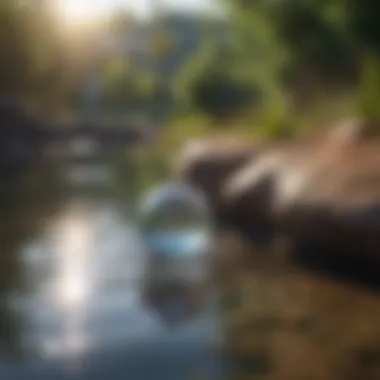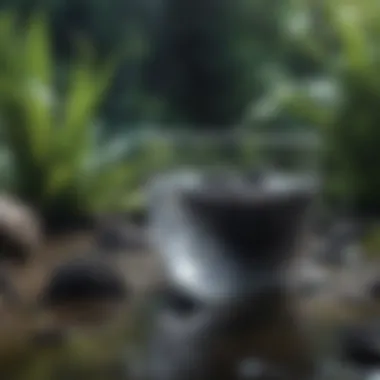Discovering Various Water Filtration Techniques for Children


Nature Topic Overview
The discussion of water filtration methods opens up a realm of understanding for young minds, shedding light on the vital importance of access to clean water. In a world where water quality is not uniform across regions, learning about filtration methods becomes crucial in ensuring safe consumption. This article on LeafLearners serves as a guiding beacon, illuminating the processes involved in turning potentially contaminated water into a refreshing drink.
Fun Facts and Trivia
For the curious young readers, here are some intriguing tidbits about water filtration that might spark interest. Did you know that sand, charcoal, and gravel can be used as natural filtering agents to purify water? Encouraging interactive learning, visuals depicting the filtration process can help visualize how impurities are removed, making it an engaging educational experience.
Wildlife Explorations
While exploring water filtration, kids can also dive into the world of aquatic life forms that depend on clean water to thrive. From tiny freshwater invertebrates to majestic river fish, the health of these organisms is closely linked to water quality. Quizzes or puzzles about aquatic habitats can foster a deeper connection with nature and promote awareness about the delicate balance in underwater ecosystems.
Environmental Awareness
Emphasizing the broader impact of clean water, this section highlights the correlation between water conservation and sustainability. Children can learn about the necessity of preserving water sources for future generations and explore ways to contribute towards environmental protection. Simple tips like reducing water wastage at home can empower young minds to be stewards of nature.
DIY Nature Activities
To reinforce the learning journey, hands-on activities await young environmental enthusiasts. Step-by-step guides on creating miniature water filtration models using everyday materials can intrigue budding scientists. Engaging in outdoor explorations to test the purified water sources firsthand adds a practical element to the theoretical knowledge gained, making the educational experience more immersive and memorable.
Introduction
Importance of Clean Water
The importance of clean water cannot be overstated. Clean water is vital for sustaining life, as our bodies rely on it for proper functioning. Access to clean water is a basic human right, yet many around the world still lack this necessity. By learning about water filtration, kids can grasp the value of maintaining water purity to prevent illnesses and promote overall well-being. Understanding the significance of clean water also instills a sense of responsibility towards conserving this precious resource for future generations.
Overview of Water Filtration


Water filtration serves as a process of removing impurities from water to make it safe for consumption. It involves various techniques to eliminate contaminants like bacteria, viruses, chemicals, and particles that may be present in water sources. By comprehending the different filtration methods, children can appreciate the science behind purification and gain knowledge on how advancements in technology have enabled us to access clean drinking water more conveniently. This overview sets the stage for a detailed exploration of traditional, modern, and natural filtration methods, offering a holistic view of water treatment practices.
Traditional Water Filtration Methods
One key element to consider in traditional water filtration methods is their simplicity and accessibility. Techniques such as boiling, cloth filtration, sedimentation, and sand filtration can be easily implemented even in resource-limited settings, making them invaluable solutions for communities facing water purification challenges. Additionally, traditional methods often rely on natural processes, eliminating the need for complex machinery or chemical additives, which aligns with sustainable and eco-friendly practices.
Boiling
Boiling stands as a time-honored method of water purification, trusted for its effectiveness in killing harmful pathogens. By heating water to its boiling point, typically 100 degrees Celsius or 212 degrees Fahrenheit, microorganisms like bacteria and viruses are destroyed, rendering water safe for consumption. Boiling is a practical and low-cost technique that can be applied anywhere with a heat source and a container.
The key benefit of boiling is its simplicity. It requires no special equipment other than a heat source, making it accessible even in remote areas or during camping trips. Boiling is also a reliable method for emergency situations when access to clean water is compromised, offering a quick and effective way to ensure water safety.
Cloth Filtration
Cloth filtration involves passing water through a fabric material to trap impurities and particles, providing a mechanical barrier to contaminants. This method is particularly useful for removing visible debris, sediment, and larger impurities from water sources. By using materials like cloth, cotton, or even a clean sock, water can be filtered to improve its clarity and taste.
A significant advantage of cloth filtration is its versatility. This method is adaptable to different settings and can be easily customized based on the available materials. Cloth filters are reusable and easy to maintain, making them a sustainable option for households or communities seeking affordable water purification solutions.
Sedimentation
Sedimentation is a natural water purification process that allows suspended particles to settle at the bottom of a container over time. By letting water sit undisturbed, gravity causes heavy particles like sand, silt, and debris to gradually sink, leaving clearer water on top. Sedimentation is a simple and effective method for reducing turbidity and removing visible sediments from water.
One key consideration for using sedimentation is the need for patience. This method requires time for sediments to settle, which may vary depending on the water quality and the amount of debris present. While sedimentation is not a sterilization method and may not eliminate all pathogens, it serves as a pre-treatment step to improve water clarity before further purification.
Sand Filtration
Sand filtration involves passing water through layers of sand to remove impurities and contaminants. Sand acts as a natural filter, trapping particles and microorganisms as water percolates through its porous structure. This method is effective in removing suspended solids, organic matter, and some disease-causing agents, enhancing water quality.


The primary benefit of sand filtration is its ability to remove a wide range of impurities. By using different grades of sand and gravel in a layered filtration system, various-sized particles can be captured, resulting in cleaner water. Sand filters are also cost-effective and easy to maintain, making them a practical option for decentralized water treatment systems.
Modern Water Filtration Technologies
Modern Water Filtration Technologies play a crucial role in ensuring access to clean and safe drinking water, especially for children. These advanced methods utilize innovative techniques to effectively remove impurities and contaminants from water sources. By incorporating Modern Water Filtration Technologies into this article, we aim to educate young readers on the significance of these processes and their impact on maintaining water quality.
Activated Carbon Filtration
Activated Carbon Filtration is a widely used method in water treatment that relies on the porous nature of activated carbon to adsorb pollutants and particles. This process effectively traps impurities, such as chemicals, solvents, and organic compounds, improving the taste and odor of water. Activated Carbon Filtration is known for its efficiency in removing chlorine, volatile organic compounds (VOCs), and other common contaminants, making it a popular choice for household water filters.
Reverse Osmosis
Reverse Osmosis is a sophisticated water filtration process that utilizes a semipermeable membrane to remove ions, molecules, and larger particles from water. By exerting pressure on the water, Reverse Osmosis effectively separates contaminants, such as lead, arsenic, nitrates, and bacteria, ensuring a high level of purification. This technology is commonly used in homes, schools, and water treatment plants due to its ability to produce clean and safe drinking water.
Ultrafiltration
Ultrafiltration is a membrane-based filtration process that removes bacteria, viruses, and pathogens from water through a fine membrane with microscopic pores. This method is effective in eliminating microbial contaminants while retaining essential minerals and nutrients in the water. Ultrafiltration is a sustainable and energy-efficient solution for water purification, providing a reliable and safe source of drinking water.
UV Water Purification
UV Water Purification harnesses the power of ultraviolet light to destroy harmful microorganisms and pathogens present in water. This technology disrupts the DNA of bacteria, viruses, and parasites, preventing them from reproducing and causing waterborne diseases. UV Water Purification does not alter the taste or chemical composition of water, making it a safe and environmentally friendly method for disinfecting drinking water.
Natural Water Filtration Methods
Natural water filtration methods are a crucial aspect of this article, shedding light on environmentally friendly ways to purify water. In a world where clean water is becoming increasingly scarce, understanding how natural processes can filter water is of paramount importance. By exploring plant filtration, aquatic organisms' role in filtration, and soil filtration, children not only learn the scientific principles at work but also gain an appreciation for the environment's innate purification abilities. Natural water filtration methods offer a sustainable and eco-friendly approach to ensuring safe drinking water, emphasizing the interconnectedness between humans and the natural world.
Plant Filtration


Plant filtration is a fascinating natural process where certain plants, such as water hyacinths and reeds, are utilized to absorb contaminants from water. These plants act as natural filters, removing impurities and pollutants through their roots and leaves. By engaging with plant filtration, kids can witness firsthand how plants play a vital role in maintaining water quality and promoting environmental balance. This hands-on experience not only educates children on the importance of vegetation in water purification but also instills a sense of responsibility towards nurturing our ecosystems.
Aquatic Organisms in Filtration
Aquatic organisms play a significant role in water filtration by consuming algae and bacteria that can contaminate water sources. Through the presence of organisms like freshwater mussels and aquatic insects, natural water bodies maintain a delicate ecological balance by controlling the growth of harmful microorganisms. Exploring the role of aquatic organisms in filtration not only educates children on the diverse ecosystem dynamics but also highlights the importance of biodiversity in preserving water quality. Encouraging kids to observe and study these organisms fosters a deeper understanding of the symbiotic relationships that sustain aquatic environments.
Soil Filtration
Soil filtration is a fundamental natural process where layers of soil effectively filter out impurities from water as it percolates through the ground. Soil acts as a natural cleanser, trapping sediments and contaminants while allowing purified water to continue its journey through underground aquifers. By delving into soil filtration, children can grasp how the Earth's soil serves as a crucial barrier that enhances water quality and replenishes groundwater reserves. Understanding the intricacies of soil filtration not only underscores the Earth's natural water purifying mechanisms but also encourages responsible land management practices to safeguard our water resources.
DIY Water Filtration Projects for Kids
Water filtration is a vital concept that children should grasp from an early age, as it instills the importance of accessing clean, safe water. Engaging kids in DIY water filtration projects not only educates them but also empowers them to create solutions. By immersing children in hands-on activities like building their own water filter, they develop practical skills while comprehending the significance of clean water. Through these projects, kids learn about the various filtration materials and methods, fostering a deeper understanding of water quality.
Build Your Own Water Filter
Building a water filter can be a fun and educational experience for kids. To start, gather materials like a plastic bottle, gravel, sand, and activated charcoal. Cut the bottom of the bottle, layer the materials, with the charcoal on top, and pour water to observe filtration in action. Explain how each material plays a role in removing impurities, and discuss the importance of clean water for health. This hands-on activity not only educates children on filtration but also encourages creativity and problem-solving skills.
Exploring Filtration with Household Items
Introduce children to water filtration using everyday household items to demonstrate water purifying concepts. Items like coffee filters, paper towels, and sieves can mimic filtration processes. Allow kids to explore how these materials separate solids from liquids, encouraging them to think critically about purification. Discuss the impact of contaminants in water and how filtration helps remove them. This interactive activity promotes scientific curiosity and environmental awareness among young learners.
Conclusion
In the vast world of information, the significance of a conclusion cannot be overstated. Concluding thoughts serve as the anchor that ties together the entire narrative, encapsulating the essence of the topic at hand. Within the context of water filtration methods for kids, the conclusion acts as a crucial junction where all the discussed methods and ideologies converge. Here, we emphasize the paramount importance of instilling in children the knowledge and awareness of water filtration. By understanding the diverse range of filtration techniques, young minds can grasp the fundamental concept of clean and safe water. Furthermore, by delving into the depths of water filtration, children can develop a profound appreciation for the resources that sustain life. Nurturing a sense of responsibility towards water conservation begins with education, and the conclusion of this article aims to inspire young readers to become stewards of our planet's most precious resource.
Summary of Water Filtration Methods
The journey through the realm of water filtration methods unveils a tapestry of techniques designed to purify this life-sustaining liquid. From traditional approaches like boiling and cloth filtration to modern innovations such as reverse osmosis and UV purification, each method plays a vital role in ensuring the safety and purity of water. Children are introduced to the fascinating interplay of science and nature as they explore how different filtration methods work. Understanding the mechanisms behind water purification not only empowers kids with knowledge but also nurtures a sense of curiosity about the world around them. Envision young minds captivated by the intricate processes that transform murky water into a crystal-clear elixir, ready for consumption. Through this exploration, children not only learn about the practical applications of science but also gain a profound respect for the importance of clean water in sustaining life.
Encouraging Water Conservation
In a world where water scarcity looms as a pressing global issue, instilling the value of water conservation in young minds is paramount. By incorporating lessons on water conservation into discussions on filtration methods, children begin to grasp the interconnectedness of clean water availability and responsible usage. Encouraging kids to adopt simple practices like turning off taps when not in use, fixing leaky faucets promptly, and being mindful of water consumption during daily activities can have a significant impact. Empowering children with the knowledge that every droplet saved contributes to a sustainable future fosters a sense of environmental stewardship. Through education on water conservation practices, kids not only learn to appreciate the preciousness of water but also realize their role as guardians of this invaluable resource.







